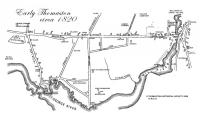
Henry Knox monument, Thomaston, ca. 1871
Thomaston Historical Society
After General Knox’s death in 1806, merchants and traders, including Ballard Green, Eli Merrill, John Paine, and Patrick Keegan continued to carry on extensive business in English and West India goods. The Honorable William King of Bath, who owned the Knox Wharf at the foot of Wadsworth Street, the Limestone Hill quarry and other valuable property mortgaged to him by Lucy Knox prior to 1820, was elected as first Governor when Maine became a state.

Early Thomaston, Maine c 1820
Thomaston Historical Society

Maine, from the United States Gazetteer, 1795
Maine Historical Society
In 1823 Gov. King sold the quarry with ten acres of property to the state for $3,000 as a site for the Maine State Prison. Since Thomaston was halfway between Kittery and Eastport with river access, it was desirable not only due to its location but also because the quarry provided a source for prison labor.
Up until the 1820s, Thomaston’s business center was concentrated at Crick Village. A dam, south of the County Road (Main Street) created a millpond, which backed up under the bridge and to the north, upon which several mills and a marble factory were built.
<- Prev. Page .............................. Next Page ->